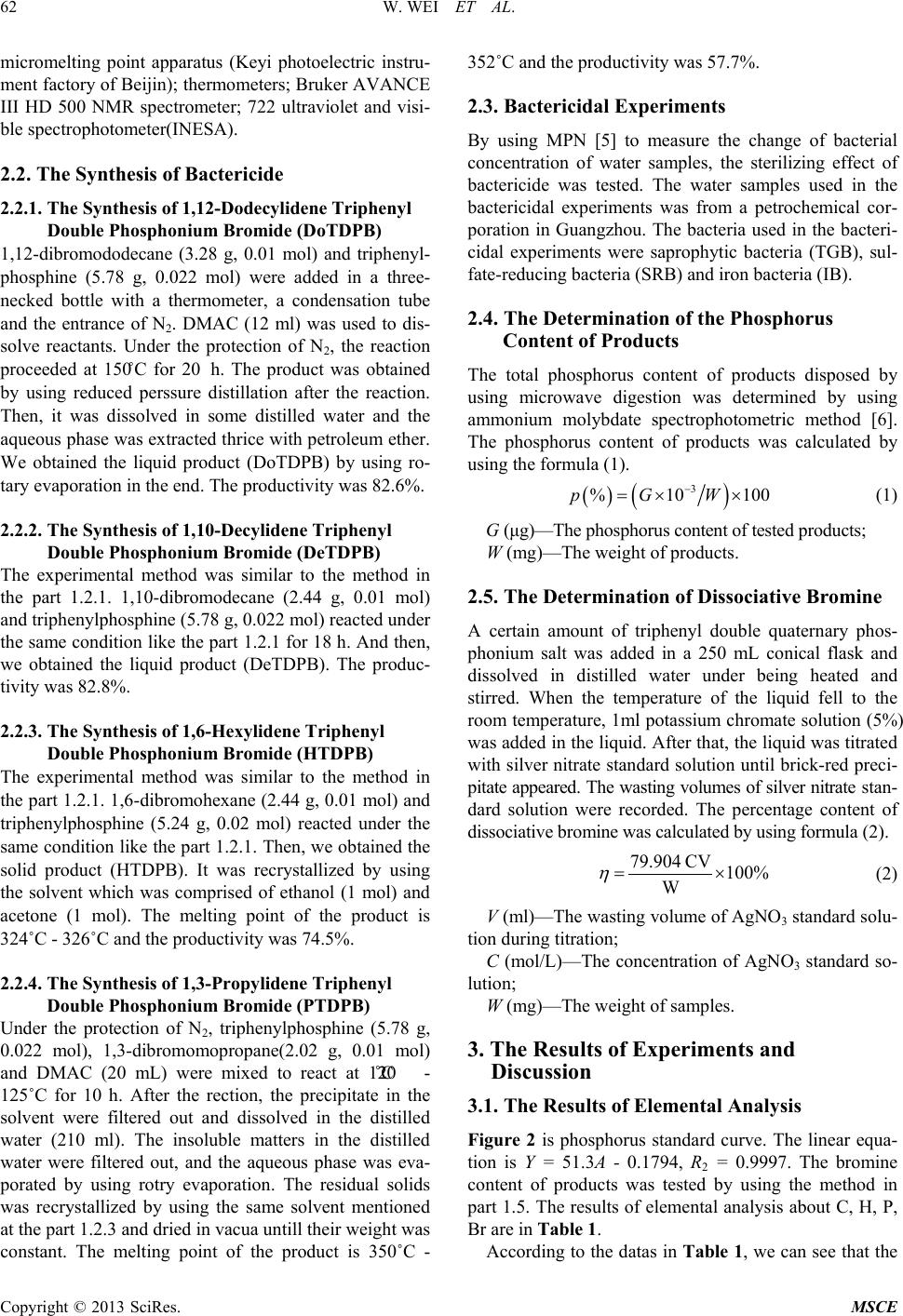
W. WEI ET AL.
Copyright © 2013 SciRes. MSCE
micromelting point apparatus (Keyi photoelectric instru-
ment factory of Beijin); thermometers; Bruker AVANCE
III HD 500 NMR spectrometer; 722 ultraviolet and visi-
ble spectrophotometer(INESA).
2.2. The Synthesis of Bac tericide
2.2.1. The Synthe sis of 1,12-Dodecylidene Tri phe nyl
Double Phosphonium Bromide (DoTDPB)
1,12-dibromododecane (3.28 g, 0.01 mol) and triphenyl-
phosphine (5.78 g, 0.022 mol) were added in a three-
necked bottle with a thermometer, a condensation tube
and the entrance of N2. DMAC (12 ml) was used to dis-
solve reactants. Under the protection of N2, the reaction
proceeded at 150˚C for 20 h. The product was obtained
by using reduced perssure distillation after the reaction.
Then, it was dissolved in some distilled water and the
aqueous phase was extracted thrice w ith petroleum ether.
We obtained the liquid product (DoTDPB) by using ro-
tary evaporation in the end. The produc t i vity was 82.6%.
2.2.2. The Synthesis of 1,10-Decylidene Triphenyl
Double Phosphonium Bromide (DeTDPB)
The experimental method was similar to the method in
the part 1.2.1. 1,10-dibromodecane (2.44 g, 0.01 mol)
and triphenylphosphine (5.78 g, 0.022 mol) reacted under
the same condition like the part 1.2.1 for 18 h. And then,
we obtained the liquid product (DeTDPB). The produc-
tivity was 82.8%.
2.2.3. The Synthesis of 1,6-Hexyliden e Triphe ny l
Double Phosphonium Bromide (HTDPB)
The experimental method was similar to the method in
the part 1.2.1. 1,6-dibromohexane (2.44 g, 0.01 mol) and
triphenylphosphine (5.24 g, 0.02 mol) reacted under the
same condition like the part 1.2.1. Then, we obtained the
solid product (HTDPB). It was recrystallized by using
the solvent which was comprised of ethanol (1 mol) and
acetone (1 mol). The melting point of the product is
324˚C - 326˚C and the productivity was 74.5%.
2.2.4. The Synthesis of 1,3-Propylidene Triphenyl
Double Phosphonium Bromide (PTDPB)
Under the protection of N2, triphenylphosphine (5.78 g,
0.022 mol), 1,3-dibromomopropane(2.02 g, 0.01 mol)
and DMAC (20 mL) were mixed to react at 120˚C -
125˚C for 10 h. After the rection, the precipitate in the
solvent were filtered out and dissolved in the distilled
water (210 ml) . The insoluble matters in the distilled
water were filtered out, and the aqueous phase was eva-
porated by using rotry evaporation. The residual solids
was recrystallized by using the same solvent mentioned
at the part 1.2.3 and dried in vacua untill their weight was
constant. The melting point of the product is 350˚C -
352˚C and the productivity was 57.7%.
2.3. Bactericidal Experiments
By using MPN [5] to measure the change of bacterial
concentration of water samples, the sterilizing effect of
bactericide was tested. The water samples used in the
bactericidal experiments was from a petrochemical cor-
poration in Guangzhou. The bacteria used in the bacteri-
cidal experiments were saprophytic bacteria (TGB), sul-
fate-redu cing bacteria (SRB) and iron bacteria (IB).
2.4. The Determination of the Phosphorus
Content of Products
The total phosphorus content of products disposed by
using microwave digestion was determined by using
ammonium molybdate spectrophotometric method [6].
The phosphorus content of products was calculated by
using the formula (1).
(1 )
G (μg)—The p hosph orus content of tested products;
W (mg ) —The weight of products.
2.5. The Determination of Di ssociative Bromine
A certain amount of triphenyl double quaternary phos-
phonium salt was added in a 250 mL conical flask and
dissolved in distilled water under being heated and
stirred. When the temperature of the liquid fell to the
room temperature, 1ml potassium chromate solution (5%)
was added in the liquid. After that, the liquid was titra ted
with silver nitrate standard solution until brick-red preci-
pitate appeared. The wasting volumes of silver nitrate stan-
dard solution were recorded. The percentage content of
dissociative bromine was calcul ated by usi ng formula (2).
(2 )
V ( ml) —The wasting volume of AgNO3 standard solu-
tion during titration;
C (mol/L)—The concentration of AgNO3 standard so-
lution;
W (mg ) —The weight of samples.
3. The Results of Experiments and
Discussion
3.1. The Results of Elemental Analysis
Figure 2 is phosphorus standard curve. The linear equa-
tion is Y = 51.3A - 0.1794, R2 = 0.9997. The bromine
content of products was tested by using the method in
part 1.5. The results of elemental analysis about C, H, P,
Br are in Table 1.
According to the datas in Table 1, we can see that the